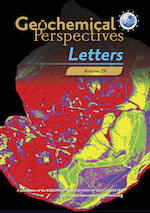Magnesiowüstite as a major nitrogen reservoir in Earth’s lowermost mantle
Affiliations | Corresponding Author | Cite as | Funding information- Share this article





-
Article views:178Cumulative count of HTML views and PDF downloads.
- Download Citation
- Rights & Permissions
top
Abstract
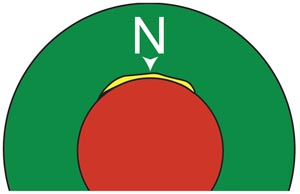
Figures
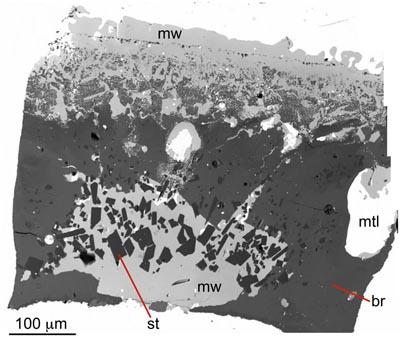 Figure 1 Backscatter electron image of sample BRG 22 (24 GPa, 1700 °C). Magnesiowüstite (mw) is light grey, Pt-bearing Fe metal (mtl) is white, bridgmanite (br) dark grey, and stishovite (st) nearly black. | 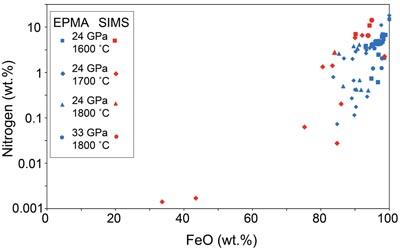 Figure 2 Nitrogen solubility in ferropericlase-magnesiowüstite solid solutions at Fe-FeO buffer conditions. Both data obtained by electron microprobe (EPMA) and by SIMS (secondary ion mass spectrometry) are shown. However, they were never measured at exactly the same spot, as nitrogen is likely lost during the measurements. Data at the same P,T conditions may be from several experiments, see Table S-1. | 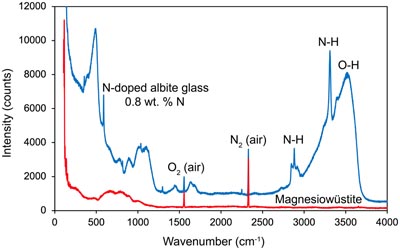 Figure 3 A comparison of the Raman spectrum of nitrogen-rich magnesiowüstite (run BRG 21) with the Raman spectrum of a reduced hydrous N-bearing albite glass with 0.8 wt. % N. The comparison clearly shows that N-H stretching vibrations would be detected in the magnesiowüstite, if the nitrogen were dissolved as ammonium ion or some other N-H species. Both spectra were acquired under the same conditions (2 times 50 s accumulation time, 200 mW output power, 514 nm argon laser). | 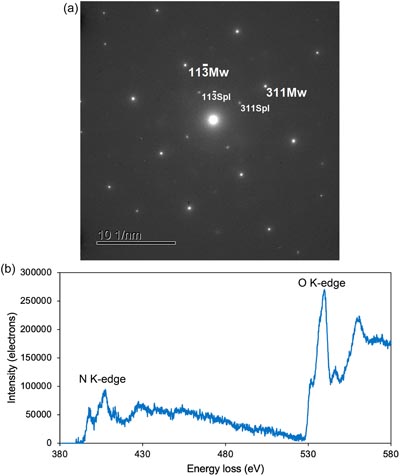 Figure 4 Transmission electron microscopic data on N-bearing magnesiowüstite. (a) Selected area electron diffraction (SAED) pattern of a sample showing that the investigated area is a single crystal of cubic magnesiowüstite (Mw) without phase impurities. Weaker diffraction spots of a spinel phase (Spl) are also visible in a complete topotaxy, with a-axis (Mw) // a-axis (Spl), indicating that this phase likely formed by exsolution during quenching. (b) ELNES (energy loss near edge structure) spectrum of N-bearing magnesiowüstite. The data show that nitrogen is contained in the lattice of the crystal and the environment of N and O are similar. |
| Figure 1 | Figure 2 | Figure 3 | Figure 4 |
top
Introduction
Nitrogen is the main constituent of Earth’s atmosphere. Nitrogen concentrations in the oceans, biomass and sediments and other near surface reservoirs are well constrained (Johnson and Goldblatt, 2015
Johnson, B., Goldblatt, C. (2015) The nitrogen budget of Earth. Earth-Science Reviews 148, 150–173. https://doi.org/10.1016/j.earscirev.2015.05.006.
). The nitrogen abundance in the convecting upper mantle is also quite well known from measurements of N/40Ar ratios of MORB samples (Marty, 1995Marty, B. (1995) Nitrogen content of the mantle inferred from N2–Ar correlation in oceanic basalts. Nature 377, 326–329. https://doi.org/10.1038/377326a0.
), which appear to be nearly unfractionated during partial melting and degassing (Keppler et al. 2022Keppler, H., Cialdella, L., Couffignal, F., Wiedenbeck, M. (2022) The solubility of N2 in silicate melts and nitrogen partitioning between upper mantle minerals and basalt. Contributions to Mineralogy and Petrology 177, 83. https://doi.org/10.1007/s00410-022-01948-z.
). If one considers the upper mantle to be representative of the entire bulk silicate Earth, these data would suggest that nitrogen on Earth is selectively depleted relative to carbon (Marty, 2012Marty, B. (2012) The origins and concentrations of water, carbon, nitrogen and noble gases on Earth. Earth and Planetary Science Letters 313, 56–66. https://doi.org/10.1016/j.epsl.2011.10.040.
). This “subchondritic N/C ratio” has been extensively discussed and has often been used to constrain details of models for the early evolution of Earth (e.g., Hirschmann, 2016Hirschmann, M.M. (2016) Constraints on the early delivery and fractionation of Earth’s major volatiles from C/H, C/N, and C/S ratios. American Mineralogist 101, 540–553. https://doi.org/10.2138/am-2016-5452.
; Li et al., 2023Li, Y., Wiedenbeck, M., Monteleone, B., Dasgupta, R., Costin, G., Gao, Z., Lu, W (2023) Nitrogen and carbon fractionation in planetary magma oceans and origin of the superchondritic C/N ratio in the bulk silicate Earth. Earth and Planetary Science Letters 605, 118032. https://doi.org/10.1016/j.epsl.2023.118032.
).There are, however, reasons to believe that the transition zone and lower mantle may be enriched in nitrogen, which would obviously call into question the concept of the “subchondritic N/C ratio” of the bulk Earth. Some samples from ocean island basalts have much higher N/40Ar ratios than MORB (Johnson and Goldblatt, 2015
Johnson, B., Goldblatt, C. (2015) The nitrogen budget of Earth. Earth-Science Reviews 148, 150–173. https://doi.org/10.1016/j.earscirev.2015.05.006.
), which could hint at a deep seated N-rich reservoir. Moreover, experimental studies (Yoshioka et al., 2018Yoshioka, T., Wiedenbeck, M., Shcheka, S., Keppler, H. (2018) Nitrogen solubility in the deep mantle and the origin of Earth’s primordial nitrogen budget. Earth and Planetary Science Letters 488, 134–143. https://doi.org/10.1016/j.epsl.2018.02.021.
) suggest that in particular, the main minerals of the mantle transition zone, wadsleyite and ringwoodite, may store much more nitrogen than the minerals of the shallow mantle. Nitrogen solubility in minerals of the lower mantle, however, is poorly constrained. There are very few data on bridgmanite, the most abundant phase (Yoshioka et al., 2018Yoshioka, T., Wiedenbeck, M., Shcheka, S., Keppler, H. (2018) Nitrogen solubility in the deep mantle and the origin of Earth’s primordial nitrogen budget. Earth and Planetary Science Letters 488, 134–143. https://doi.org/10.1016/j.epsl.2018.02.021.
) and no data at all on ferropericlase, the second most abundant phase. In the present study we systematically investigated N solubility in the ferropericlase (Mg,Fe)O-magnesiowüstite (Fe,Mg)O solid solution series.top
Methods
Ferropericlase or magnesiowüstite were synthesised together with other minerals (mostly bridgmanite) at 20–33 GPa and 1600–1800 °C in the presence of an N-rich fluid phase. Starting materials were oxide (SiO2-MgO) hydroxide (Mg(OH)2-Al(OH)3) mixtures with bridgmanite (MgSiO3) stoichiometry, sometimes containing up to 10 wt. % Al2O3. Metallic Fe was added to all charges either as powder or as 1mm thick disks to buffer oxygen fugacity near the Fe-FeO (iron wüstite) equilibrium, which is realistic for the lower mantle (Frost and McCammon, 2008
Frost, D., McCammon, C. (2008) The redox state of Earth’s mantle. Annual Review of Earth and Planetary Sciences 36, 389–420. https://doi.org/10.1146/annurev.earth.36.031207.124322.
). A N-rich fluid phase was generated by adding isotopically labelled ammonium nitrate 15NH415NO3 to the charge, which was sealed into Pt capsules. The weight ratio of metallic Fe to 15NH415NO3 and to the oxide-hydroxide mixture loaded in each capsule was about 5:1:2. Experiments up to 24 GPa were carried out in a conventional, Kawai-type multi-anvil apparatus. For experiments at higher pressures, a multi-anvil press of new design was used (Ishii et al., 2016Ishii, T., Shi, L., Huang, R., Tsujino, N., Druzhbin, D., Myhill, R., Li, Y., Wang, L., Yamamoto, T., Miyajima, N., Kawazoe, T., Nishiyama, N., Higo, Y., Tange, Y., Katsura, T. (2016) Generation of pressures over 40 GPa using Kawai-type multi-anvil apparatus with tungsten carbide anvils. Reviews of Scientific Instruments 87, 024501. https://doi.org/10.1063/1.4941716.
).The samples recovered from high pressure experiments were embedded into epoxy resin, sectioned and polished. Nitrogen contents were measured both by electron microprobe (JEOL JXA-8200) and by SIMS (secondary ion microprobe analysis) using the Cameca 1280-HR instrument at GFZ Potsdam. For microprobe measurements, an acceleration voltage of 10 kV, beam current of 15 nA, and a 5 μm diameter defocused beam were used together with the following standards: Andradite and metallic iron for Fe, diopside for Mg, metallic platinum for Pt and boron nitride for N. For SIMS measurements, samples were coated with a 35 nm high purity gold layer. Measurements were carried out with a 16O− primary beam focused to a 10 μm diameter spot, 13 kV primary acceleration voltage, and 20–24 nA primary current. 15N implanted forsterite was used as calibrant material. For further details, see Yoshioka et al. (2018)
Yoshioka, T., Wiedenbeck, M., Shcheka, S., Keppler, H. (2018) Nitrogen solubility in the deep mantle and the origin of Earth’s primordial nitrogen budget. Earth and Planetary Science Letters 488, 134–143. https://doi.org/10.1016/j.epsl.2018.02.021.
.In order to constrain the dissolution mechanism of nitrogen, the samples were also studied by Raman spectroscopy and by transmission electron microscopy (TEM). Raman spectra were measured with a Horiba Labram 800 HR-UV confocal spectrometer using the 514 nm line of a Coherent argon laser at 200 mW output power. TEM studies were carried out with a 200 kV FEI Titan instrument. Further experimental details are given in the Supplementary Information.
top
Nitrogen Solubility in Ferropericlase-Magnesiowüstite
A summary of all our high pressure experiments and analytical results is given in Tables S-1 and S-2. Figure 1 shows a typical run product. At pressures above 24 GPa, magnesiowüstite (or ferropericlase, depending on composition) coexists with bridgmanite and a metallic phase containing iron, as expected for the lower mantle. Other phases, in particular stishovite, are occasionally observed. In the majority of the experiments, most of the magnesiowüstite formed by the oxidation of a portion of the Fe metal that was initially added, which explains the rather Fe-rich compositions in most experiments. Measured nitrogen contents in the (Fe,Mg)O phase are shown in Figure 2 as function of FeO content. Nitrogen solubility in ferropericlase-magnesiowüstite increases from a few 10 μg/g for Mg-rich compositions to 18 wt. % (!) for the Fe end member. In general, the data from SIMS measurements define a consistent trend with only few outliers. The microprobe measurements (see also Table S-1) overlap with the SIMS data but most of them are displaced to lower values. This is likely due to degassing during the microprobe measurements, as the sample is heated in vacuum by the electron beam. Indeed, in a scan of the X-ray spectrum of the most N-rich samples, the nitrogen Kα line was clearly visible before the measurements, while it was invisible afterwards. Despite these analytical problems, we show the microprobe data here, as they provide an independent confirmation of the very high nitrogen contents obtained by SIMS. We cannot exclude that local heating may also occur during SIMS measurements, therefore our SIMS and microprobe measurements were never carried out at exactly the same locations. Some of the scatter seen in Figure 2 may also be related to variations in oxygen fugacity. The Fe metal in the runs is to a variable extent alloyed with Pt (see Table S-1) and this effect will shift the oxygen fugacity to values above the Fe-FeO buffer, which is expected to reduce nitrogen solubility in minerals (e.g., Li et al., 2013
Li, Y., Wiedenbeck, M., Shcheka, S., Keppler, H. (2013) Nitrogen solubility in upper mantle minerals. Earth and Planetary Science Letters 377, 311–323. https://doi.org/10.1016/j.epsl.2013.07.013.
). The FeO contents in Figure 2 and Table S-1 were obtained by the usual standard procedures used for oxide and silicate analyses, i.e. all Fe was assumed to be Fe2+ and expressed as FeO. However, in reality (see the discussion below), some Fe is present as nitride in solid solution. For the most Fe-rich samples, this procedure produces totals (FeO + MgO + N) that may exceed 100 %. No attempt was made to correct for this.
Figure 1 Backscatter electron image of sample BRG 22 (24 GPa, 1700 °C). Magnesiowüstite (mw) is light grey, Pt-bearing Fe metal (mtl) is white, bridgmanite (br) dark grey, and stishovite (st) nearly black.

Figure 2 Nitrogen solubility in ferropericlase-magnesiowüstite solid solutions at Fe-FeO buffer conditions. Both data obtained by electron microprobe (EPMA) and by SIMS (secondary ion mass spectrometry) are shown. However, they were never measured at exactly the same spot, as nitrogen is likely lost during the measurements. Data at the same P,T conditions may be from several experiments, see Table S-1.
top
Nitrogen Substitution Mechanism in Ferropericlase-Magnesiowüstite
Wüstite is a non-stoichiometric phase, often written as Fe1-xO. This is because some of the iron is present as Fe3+ (even at low oxygen fugacities), which is then charge compensated by Fe2+ vacancies. An alternative possibility of charge compensation for Fe3+ would be the substitution of Fe2+ by a univalent cation, such as Na+. Indeed, samples of ferropericlase from the mantle can have elevated sodium contents (Brey et al., 2004
Brey, G.P., Bulatov, V., Girnisc, A., Harris, J.W., Stachel, T. (2004) Ferropericlase—a lower mantle phase in the upper mantle. Lithos 77, 655–663. https://doi.org/10.1016/j.lithos.2004.03.013.
). Instead of Na+, perhaps also the ammonium ion NH4+ could be incorporated into magnesiowüstite, which would be a possible mechanism for accommodating the exceptionally high nitrogen solubilities reported here. NH4+ would be easily detectable by Raman spectroscopy due to the N-H stretching vibrations near 3100 cm-1. We therefore measured Raman spectra of some of the most N-rich samples of magnesiowüstite. However, the spectra were completely featureless (Fig. 3). For pure magnesiowüstite (or ferropericlase), this is expected, as there is no Raman active vibrational mode in the rock salt structure. Significant ammonium concentrations should certainly be detectable by Raman spectroscopy. To demonstrate this, a hydrous albite glass with just 0.8 wt. % N was measured under the same conditions and clearly showed N-H bands (Fig. 3; see also Fig. S-1). Therefore, dissolution of nitrogen as NH4+ can be ruled out as the main substitution mechanism.
Figure 3 A comparison of the Raman spectrum of nitrogen-rich magnesiowüstite (run BRG 21) with the Raman spectrum of a reduced hydrous N-bearing albite glass with 0.8 wt. % N. The comparison clearly shows that N-H stretching vibrations would be detected in the magnesiowüstite, if the nitrogen were dissolved as ammonium ion or some other N-H species. Both spectra were acquired under the same conditions (2 times 50 s accumulation time, 200 mW output power, 514 nm argon laser).
To further constrain the nitrogen substitution mechanism, some samples were studied by TEM (transmission electron microscopy). Electron diffraction patterns (Fig. 4a) showed that the magnesiowüstite with high N content is actually present in the form of single crystals without any phase impurities. High resolution images revealed the local presence of some nanoscale topotaxial spinel phase, which likely formed as exsolution during quenching and which is not associated with the high N contents (see Figs. S-2, S-3, and S-4). Figure 4b shows an ELNES (electron energy loss near edge structure) spectrum of a single crystal area of N-rich magnesiowüstite. The similarity of the fine structure of the N K-edge and the O K-edge suggest that N and O occur in the structure in the same coordination environment, i.e. N directly substitutes for O. In other words, the N-rich magnesiowüstite samples may be described as a solid solution of FeO with FeN. This is consistent with the description of NiAs-structured FeN that may be synthesised by direct reaction of N2 with metallic iron above 17 GPa (Laniel et al., 2018
Laniel, D., Dewaele, A., Anzellini, S., Guignot, N. (2018) Study of the iron nitride FeN into the megabar regime. Journal of Alloys and Compounds 733, 53–58. https://doi.org/10.1016/j.jallcom.2017.10.267.
). The bonding in this FeN phase is probably largely metallic, such that it cannot be properly described with an ionic model. From a structural point of view, a significant miscibility between FeO and FeN is plausible, as the NiAs structure of FeN differs from the NaCl structure of FeO only by the stacking sequence of the densely packed anion layers. Indeed, extended solid solutions between structurally similar nitrides and oxides have been reported in the materials science literature (e.g., Maeda et al., 2005Maeda, K., Takata, T., Hara, M., Saito, N., Inoue, Y., Kobayashi, H., Domen, K. (2005) GaN:ZnO solid solution as a photocatalyst for visible-light-driven overall water splitting. Journal of the American Chemical Society 127, 8286–8287. https://doi.org/10.1021/ja0518777
). The strong decrease of nitrogen solubility in magnesiowüstite with increasing Mg content may then be related to the transition from a mostly metallic to a dominantly ionic bonding environment in the crystal.
Figure 4 Transmission electron microscopic data on N-bearing magnesiowüstite. (a) Selected area electron diffraction (SAED) pattern of a sample showing that the investigated area is a single crystal of cubic magnesiowüstite (Mw) without phase impurities. Weaker diffraction spots of a spinel phase (Spl) are also visible in a complete topotaxy, with a-axis (Mw) // a-axis (Spl), indicating that this phase likely formed by exsolution during quenching. (b) ELNES (energy loss near edge structure) spectrum of N-bearing magnesiowüstite. The data show that nitrogen is contained in the lattice of the crystal and the environment of N and O are similar.
top
Nitrogen in the Lower Mantle and in the Ultralow Velocity Zones Above the Core
The molar fraction of Fe in ferropericlase in a pyrolitic lower mantle is likely between 0.1 and 0.3 depending on depth (e.g., Irifune et al., 2010
Irifune, T., Shinmei, T., McCammon, C.A., Miyajima, N., Rubie, D.C., Frost, D.J. (2010) Iron partitioning and density changes of pyrolite in Earth’s lower mantle. Science 327, 193–195. https://doi.org/10.1126/science.1181443.
; Muir and Brodholt, 2016Muir, J.M.R., Brodholt, J.P. (2016) Ferrous iron partitioning in the lower mantle. Physics of the Earth and Planetary Interiors 257, 12–17. https://doi.org/10.1016/j.pepi.2016.05.008.
). This translates into a composition of 16–43 wt. % FeO. As one may see from Figure 2, this corresponds to a nitrogen solubility in the range of a few tens μg/g. These numbers are comparable to the nitrogen solubility in bridgmanite (near 20 μg/g for Al-free bridgmanite; Yoshioka et al., 2018Yoshioka, T., Wiedenbeck, M., Shcheka, S., Keppler, H. (2018) Nitrogen solubility in the deep mantle and the origin of Earth’s primordial nitrogen budget. Earth and Planetary Science Letters 488, 134–143. https://doi.org/10.1016/j.epsl.2018.02.021.
). The estimates of Yoshioka et al. (2018)Yoshioka, T., Wiedenbeck, M., Shcheka, S., Keppler, H. (2018) Nitrogen solubility in the deep mantle and the origin of Earth’s primordial nitrogen budget. Earth and Planetary Science Letters 488, 134–143. https://doi.org/10.1016/j.epsl.2018.02.021.
of the total nitrogen storage capacity of the lower mantle of 25 PAN (present atmospheric masses of nitrogen) would therefore require a significant upward revision. Even more interesting than the situation in the bulk lower mantle are the consequences of the data presented here for nitrogen sequestration just above the core-mantle boundary.Numerous seismic studies have detected zones of ultralow seismic velocities (ULVZs) at various locations just above the core-mantle boundary (e.g., Williams et al., 1998
Williams, Q., Revenaugh, J., Garnero, E. (1998) A correlation between ultra-low basal velocities in the mantle and hot spots. Science 281, 546–554. https://doi.org/10.1126/science.281.5376.546.
; Cottaar and Romanowicz, 2012Cottaar, S., Romanowicz, B. (2012) An unusually large ULVZ at the base of the mantle near Hawaii. Earth and Planetary Science Letters 355–356, 213–222. https://doi.org/10.1016/j.epsl.2012.09.005.
; Thorne et al., 2013Thorne, M.S., Garnero, E.J., Jahnke, G., Igel, H., McNamara, A.K. (2013) Mega ultra low velocity zone and mantle flow. Earth and Planetary Science Letters 364, 59–67. https://doi.org/10.1016/j.epsl.2012.12.034.
). Various hypotheses have been proposed to explain these features. Initially, it was widely believed that the presence of partial melt (e.g., Williams et al., 1998Williams, Q., Revenaugh, J., Garnero, E. (1998) A correlation between ultra-low basal velocities in the mantle and hot spots. Science 281, 546–554. https://doi.org/10.1126/science.281.5376.546.
) might be responsible for the observed drop in seismic velocities. However, over the last decade, alternative models have received more support, which attribute these zones to chemical anomalies with very Fe-rich compositions containing near end member magnesiowüstite (Wicks et al., 2010Wicks, J.K., Jackson, J.M., Sturhahn, W. (2010) Very low sound velocities in iron‐rich (Mg,Fe)O: Implications for the core‐mantle boundary region. Geophysical Research Letters 37, L15304. https://doi.org/10.1029/2010GL043689.
; Sun et al., 2013Sun, D., Helmberger, D.V., Jackson, J.M., Clayton, R.W., Bower, D.J. (2013) Rolling hills on the core–mantle boundary. Earth and Planetary Science Letters 361, 333–342. https://doi.org/10.1016/j.epsl.2012.10.027.
; Brown et al., 2015Brown, S. P., Thorne, M. S., Miyagi, L., Rost, S. (2015) A compositional origin to ultralow-velocity zones. Geophysical Research Letters 42. https://doi.org/10.1002/2014GL062097.
). Various models have been proposed for the origin of these Fe-enriched zones. They may perhaps be “sediments” of material exsolved from the liquid core (Buffett et al., 2000Buffett, B.A., Garnero, E.J., Jeanloz, R. (2000) Sediments at the top of Earth’s core. Science 290, 1338–1342. https://doi.org/10.1126/science.290.5495.1338.
) or consist of subducted banded iron formation (Dobson and Brodholt, 2005Dobson, D.P., Brodholt, J.P. (2005) Subducted banded iron formations as a source of ultralow-velocity zones at the core-mantle boundary. Nature 434, 371–374. https://doi.org/10.1038/nature03430.
). An alternative idea is that these Fe-rich zones are remnants of the fractional crystallisation of a deep magma ocean, which caused increasingly Fe-rich minerals to be deposited at the core-mantle boundary during the Hadean (Labrosse et al., 2007Labrosse, S., Hernlund, J.W., Coltice, N. (2007) A crystallizing dense magma ocean at the base of the Earth’s mantle. Nature 450, 866–869. https://doi.org/10.1038/nature06355.
). If this latter model is correct, it would imply that these ULVZs may have concentrated most of the nitrogen that was originally dissolved in a magma ocean. This is so because the nitrogen solubility in magnesiowüstite measured here is one to two orders of magnitude higher than the nitrogen solubility in a silicate melt measured under comparable conditions of pressure, temperature, and oxygen fugacity (Roskosz et al., 2013Roskosz, M., Bouhifd, M., Jephcoat, A., Marty, B., Mysen, B. (2013) Nitrogen solubility in molten metal and silicate at high pressure and temperature. Geochimica et Cosmochimica Acta 121, 15–28. https://doi.org/10.1016/j.gca.2013.07.007.
). While nitrogen is more or less incompatible in all other phases that may crystallise from a magma ocean (Li et al., 2013Li, Y., Wiedenbeck, M., Shcheka, S., Keppler, H. (2013) Nitrogen solubility in upper mantle minerals. Earth and Planetary Science Letters 377, 311–323. https://doi.org/10.1016/j.epsl.2013.07.013.
; Yoshioka et al., 2018Yoshioka, T., Wiedenbeck, M., Shcheka, S., Keppler, H. (2018) Nitrogen solubility in the deep mantle and the origin of Earth’s primordial nitrogen budget. Earth and Planetary Science Letters 488, 134–143. https://doi.org/10.1016/j.epsl.2018.02.021.
), the data presented here suggest that it would be highly enriched in Fe-rich magnesiowüstite that would precipitate just above the core-mantle boundary.A rough calculation may demonstrate that the ULVZs above the core-mantle boundary may very well be a major nitrogen reservoir in the solid Earth. For the following discussion, we ignore any nitrogen partitioning into the core, since for the very reducing conditions of Earth’s early accretion predicted by current models, N behaves as a lithophile element (e.g., Speelmanns et al., 2019
Speelmanns, I.M., Schmidt, M.W., Liebske, C. (2019) The almost lithophile character of nitrogen during core formation. Earth and Planetary Science Letters 510, 186–197. https://doi.org/10.1016/j.epsl.2019.01.004
). Enstatite chondrites, which may resemble most of the material that accreted to form the Earth, contain about 605 μg/g N, whereas the concentration of N in carbonaceous chondrites is on average more than twice as high (Johnson and Goldblatt, 2015Johnson, B., Goldblatt, C. (2015) The nitrogen budget of Earth. Earth-Science Reviews 148, 150–173. https://doi.org/10.1016/j.earscirev.2015.05.006.
). If the bulk N content of the accreting Earth was near that of enstatite chondrites, this would translate in a N2 partial pressure of about 700 bar in a primordial atmosphere above a magma ocean (Yoshioka et al., 2018Yoshioka, T., Wiedenbeck, M., Shcheka, S., Keppler, H. (2018) Nitrogen solubility in the deep mantle and the origin of Earth’s primordial nitrogen budget. Earth and Planetary Science Letters 488, 134–143. https://doi.org/10.1016/j.epsl.2018.02.021.
). According to Libourel et al. (2003)Libourel, G., Marty, B., Humbert, F. (2003) Nitrogen solubility in basaltic melt. Part I. Effect of oxygen fugacity. Geochimica et Cosmochimica Acta 67, 4123–4135. https://doi.org/10.1016/S0016-7037(03)00259-X.
, N2 solubility in a basaltic melt is about 0.06 (μg/g)/bar at conditions near the iron wüstite buffer; it may become even larger at more reducing conditions and at high H2O fugacities (Li et al., 2015Li, Y., Huang, R., Wiedenbeck, M., Keppler (2015) Nitrogen distribution between aqueous fluids and silicate melts. Earth and Planetary Science Letters 411, 218–228. https://doi.org/10.1016/j.epsl.2014.11.050.
; Bernadou et al., 2021Bernadou, F., Gaillard, F., Füri, E., Marrocchi, Y., Slodczyk, A. (2021) Nitrogen solubility in basaltic silicate melt - Implications for degassing processes. Chemical Geology 573, 120192. https://doi.org/10.1016/j.chemgeo.2021.120192.
). If one accepts the rather conservative solubility of 0.06 (μg/g)/bar, this would imply that the magma ocean in equilibrium with the primordial atmosphere may have contained 42 μg/g N, equivalent to 1.70 · 1020 kg. If only 20 % of the mass of this magma ocean had been trapped somewhere deep in the mantle during progressive crystallisation, as suggested by Labrosse et al. (2007)Labrosse, S., Hernlund, J.W., Coltice, N. (2007) A crystallizing dense magma ocean at the base of the Earth’s mantle. Nature 450, 866–869. https://doi.org/10.1038/nature06355.
, it would contain a N reservoir of 3.4 · 1019 kg, more than 8 PAN (present atmospheric masses of nitrogen). Upon crystallisation of this deep magma reservoir, both nitrogen and Fe would become enriched in the residual melt, ultimately leading to the precipitation of very Fe-rich magnesiowüstite that is presently contained in the ULVZs. If one assumes that these ULVZs are about 15 km thick (e.g., Cottaar and Romanowicz, 2012Cottaar, S., Romanowicz, B. (2012) An unusually large ULVZ at the base of the mantle near Hawaii. Earth and Planetary Science Letters 355–356, 213–222. https://doi.org/10.1016/j.epsl.2012.09.005.
) and cover approximately 10 % of the core-mantle boundary, they would contain 13 wt. % N, if all the N in the deep melt reservoir were sequestered in there. This number is quite consistent with the measured solubilities of N in magnesiowüstite.top
Is the “Subchondritic N/C Ratio of the Earth” Real?
Maybe not. The data presented here show that a very small and probably very poorly sampled reservoir near the core-mantle boundary could contain enough nitrogen to make the roughly one order of magnitude (Marty, 2012
Marty, B. (2012) The origins and concentrations of water, carbon, nitrogen and noble gases on Earth. Earth and Planetary Science Letters 313, 56–66. https://doi.org/10.1016/j.epsl.2011.10.040.
) apparent depletion of N relative to C in the bulk Earth disappear. This further emphasises a conclusion reached already by Yoshioka et al. (2018)Yoshioka, T., Wiedenbeck, M., Shcheka, S., Keppler, H. (2018) Nitrogen solubility in the deep mantle and the origin of Earth’s primordial nitrogen budget. Earth and Planetary Science Letters 488, 134–143. https://doi.org/10.1016/j.epsl.2018.02.021.
that the solubilities of N in ordinary minerals of the transition zone or the lower mantle are large enough that the deep mantle could have sequestered a large fraction of Earth’s nitrogen during magma ocean crystallisation. On the other hand, while the N content of the depleted MORB-source mantle (e.g. Marty, 1995Marty, B. (1995) Nitrogen content of the mantle inferred from N2–Ar correlation in oceanic basalts. Nature 377, 326–329. https://doi.org/10.1038/377326a0.
) is very well constrained, data on the deep mantle are sparse. While many ocean island basalts do indeed have N/40Ar ratios similar to MORB, there are also some samples with much higher values (Johnson and Goldblatt, 2015Johnson, B., Goldblatt, C. (2015) The nitrogen budget of Earth. Earth-Science Reviews 148, 150–173. https://doi.org/10.1016/j.earscirev.2015.05.006.
) that may hint at a deep hidden reservoir. Based on our current state of knowledge, the bulk N/C ratio of the Earth appears to be rather uncertain and this ratio should not be used as a parameter for constraining planetary accretion models (e.g., Hirschmann, 2016Hirschmann, M.M. (2016) Constraints on the early delivery and fractionation of Earth’s major volatiles from C/H, C/N, and C/S ratios. American Mineralogist 101, 540–553. https://doi.org/10.2138/am-2016-5452.
; Li et al., 2023Li, Y., Wiedenbeck, M., Monteleone, B., Dasgupta, R., Costin, G., Gao, Z., Lu, W (2023) Nitrogen and carbon fractionation in planetary magma oceans and origin of the superchondritic C/N ratio in the bulk silicate Earth. Earth and Planetary Science Letters 605, 118032. https://doi.org/10.1016/j.epsl.2023.118032.
).top
Acknowledgements
Takahiro Yoshioka kindly carried out some of the early experiments in this project. We thank Dorothea Wiesner for the preparation of the TEM thin foil by FIB. This work was supported by Deutsche Forschungsgemeinschaft (DFG; grant Ke 501/13-2 to HK). Comments by Raúl Fonseca and reviews by Mathieu Roskosz and by an anonymous referee helped to improve the manuscript.
Editor: Raúl O.C. Fonseca
top
References
Bernadou, F., Gaillard, F., Füri, E., Marrocchi, Y., Slodczyk, A. (2021) Nitrogen solubility in basaltic silicate melt - Implications for degassing processes. Chemical Geology 573, 120192. https://doi.org/10.1016/j.chemgeo.2021.120192
 Show in context
Show in context According to Libourel et al. (2003), N2 solubility in a basaltic melt is about 0.06 (μg/g)/bar at conditions near the iron wüstite buffer; it may become even larger at more reducing conditions and at high H2O fugacities (Li et al., 2015; Bernadou et al., 2021).
View in article
Brey, G.P., Bulatov, V., Girnisc, A., Harris, J.W., Stachel, T. (2004) Ferropericlase—a lower mantle phase in the upper mantle. Lithos 77, 655–663. https://doi.org/10.1016/j.lithos.2004.03.013
 Show in context
Show in context Indeed, samples of ferropericlase from the mantle can have elevated sodium contents (Brey et al., 2004).
View in article
Brown, S. P., Thorne, M. S., Miyagi, L., Rost, S. (2015) A compositional origin to ultralow-velocity zones. Geophysical Research Letters 42. https://doi.org/10.1002/2014GL062097
 Show in context
Show in context However, over the last decade, alternative models have received more support, which attribute these zones to chemical anomalies with very Fe-rich compositions containing near end member magnesiowüstite (Wicks et al., 2010; Sun et al., 2013; Brown et al., 2015).
View in article
Buffett, B.A., Garnero, E.J., Jeanloz, R. (2000) Sediments at the top of Earth’s core. Science 290, 1338–1342. https://doi.org/10.1126/science.290.5495.1338
 Show in context
Show in context They may perhaps be “sediments” of material exsolved from the liquid core (Buffett et al., 2000) or consist of subducted banded iron formation (Dobson and Brodholt, 2005).
View in article
Cottaar, S., Romanowicz, B. (2012) An unusually large ULVZ at the base of the mantle near Hawaii. Earth and Planetary Science Letters 355–356, 213–222. https://doi.org/10.1016/j.epsl.2012.09.005
 Show in context
Show in context Numerous seismic studies have detected zones of ultralow seismic velocities (ULVZs) at various locations just above the core-mantle boundary (e.g., Williams et al., 1998; Cottaar and Romanowicz, 2012; Thorne et al., 2013).
View in article
If one assumes that these ULVZs are about 15 km thick (e.g., Cottaar and Romanowicz, 2012) and cover approximately 10 % of the core-mantle boundary, they would contain 13 wt. % N, if all the N in the deep melt reservoir were sequestered in there.
View in article
Dobson, D.P., Brodholt, J.P. (2005) Subducted banded iron formations as a source of ultralow-velocity zones at the core-mantle boundary. Nature 434, 371–374. https://doi.org/10.1038/nature03430
 Show in context
Show in context They may perhaps be “sediments” of material exsolved from the liquid core (Buffett et al., 2000) or consist of subducted banded iron formation (Dobson and Brodholt, 2005).
View in article
Frost, D., McCammon, C. (2008) The redox state of Earth’s mantle. Annual Review of Earth and Planetary Sciences 36, 389–420. https://doi.org/10.1146/annurev.earth.36.031207.124322
 Show in context
Show in context Metallic Fe was added to all charges either as powder or as 1mm thick disks to buffer oxygen fugacity near the Fe-FeO (iron wüstite) equilibrium, which is realistic for the lower mantle (Frost and McCammon, 2008).
View in article
Hirschmann, M.M. (2016) Constraints on the early delivery and fractionation of Earth’s major volatiles from C/H, C/N, and C/S ratios. American Mineralogist 101, 540–553. https://doi.org/10.2138/am-2016-5452
 Show in context
Show in context This “subchondritic N/C ratio” has been extensively discussed and has often been used to constrain details of models for the early evolution of Earth (e.g., Hirschmann, 2016; Li et al., 2023).
View in article
Based on our current state of knowledge, the bulk N/C ratio of the Earth appears to be rather uncertain and this ratio should not be used as a parameter for constraining planetary accretion models (e.g., Hirschmann, 2016; Li et al., 2023).
View in article
Irifune, T., Shinmei, T., McCammon, C.A., Miyajima, N., Rubie, D.C., Frost, D.J. (2010) Iron partitioning and density changes of pyrolite in Earth’s lower mantle. Science 327, 193–195. https://doi.org/10.1126/science.1181443
 Show in context
Show in context The molar fraction of Fe in ferropericlase in a pyrolitic lower mantle is likely between 0.1 and 0.3 depending on depth (e.g., Irifune et al., 2010; Muir and Brodholt, 2016).
View in article
Ishii, T., Shi, L., Huang, R., Tsujino, N., Druzhbin, D., Myhill, R., Li, Y., Wang, L., Yamamoto, T., Miyajima, N., Kawazoe, T., Nishiyama, N., Higo, Y., Tange, Y., Katsura, T. (2016) Generation of pressures over 40 GPa using Kawai-type multi-anvil apparatus with tungsten carbide anvils. Reviews of Scientific Instruments 87, 024501. https://doi.org/10.1063/1.4941716
 Show in context
Show in context Experiments up to 24 GPa were carried out in a conventional, Kawai-type multi-anvil apparatus. For experiments at higher pressures, a multi-anvil press of new design was used (Ishii et al., 2016).
View in article
Johnson, B., Goldblatt, C. (2015) The nitrogen budget of Earth. Earth-Science Reviews 148, 150–173. https://doi.org/10.1016/j.earscirev.2015.05.006
 Show in context
Show in context Nitrogen is the main constituent of Earth’s atmosphere. Nitrogen concentrations in the oceans, biomass and sediments and other near surface reservoirs are well constrained (Johnson and Goldblatt, 2015).
View in article
Some samples from ocean island basalts have much higher N/40Ar ratios than MORB (Johnson and Goldblatt, 2015), which could hint at a deep seated N-rich reservoir.
View in article
Enstatite chondrites, which may resemble most of the material that accreted to form the Earth, contain about 605 μg/g N, whereas the concentration of N in carbonaceous chondrites is on average more than twice as high (Johnson and Goldblatt, 2015).
View in article
While many ocean island basalts do indeed have N/40Ar ratios similar to MORB, there are also some samples with much higher values (Johnson and Goldblatt, 2015) that may hint at a deep hidden reservoir.
View in article
Keppler, H., Cialdella, L., Couffignal, F., Wiedenbeck, M. (2022) The solubility of N2 in silicate melts and nitrogen partitioning between upper mantle minerals and basalt. Contributions to Mineralogy and Petrology 177, 83. https://doi.org/10.1007/s00410-022-01948-z
 Show in context
Show in context The nitrogen abundance in the convecting upper mantle is also quite well known from measurements of N/40Ar ratios of MORB samples (Marty, 1995), which appear to be nearly unfractionated during partial melting and degassing (Keppler et al. 2022).
View in article
Labrosse, S., Hernlund, J.W., Coltice, N. (2007) A crystallizing dense magma ocean at the base of the Earth’s mantle. Nature 450, 866–869. https://doi.org/10.1038/nature06355
 Show in context
Show in context An alternative idea is that these Fe-rich zones are remnants of the fractional crystallisation of a deep magma ocean, which caused increasingly Fe-rich minerals to be deposited at the core-mantle boundary during the Hadean (Labrosse et al., 2007).
View in article
If one accepts the rather conservative solubility of 0.06 (μg/g)/bar, this would imply that the magma ocean in equilibrium with the primordial atmosphere may have contained 42 μg/g N, equivalent to 1.70 · 1020 kg.
View in article
If only 20 % of the mass of this magma ocean had been trapped somewhere deep in the mantle during progressive crystallisation, as suggested by Labrosse et al. (2007), it would contain a N reservoir of 3.4 · 1019 kg, more than 8 PAN (present atmospheric masses of nitrogen).
View in article
Laniel, D., Dewaele, A., Anzellini, S., Guignot, N. (2018) Study of the iron nitride FeN into the megabar regime. Journal of Alloys and Compounds 733, 53–58. https://doi.org/10.1016/j.jallcom.2017.10.267
 Show in context
Show in context This is consistent with the description of NiAs-structured FeN that may be synthesised by direct reaction of N2 with metallic iron above 17 GPa (Laniel et al., 2018).
View in article
Li, Y., Wiedenbeck, M., Shcheka, S., Keppler, H. (2013) Nitrogen solubility in upper mantle minerals. Earth and Planetary Science Letters 377, 311–323. https://doi.org/10.1016/j.epsl.2013.07.013
 Show in context
Show in context The Fe metal in the runs is to a variable extent alloyed with Pt (see Table S-1) and this effect will shift the oxygen fugacity to values above the Fe-FeO buffer, which is expected to reduce nitrogen solubility in minerals (e.g., Li et al., 2013).
View in article
While nitrogen is more or less incompatible in all other phases that may crystallise from a magma ocean (Li et al., 2013; Yoshioka et al., 2018), the data presented here suggest that it would be highly enriched in Fe-rich magnesiowüstite that would precipitate just above the core-mantle boundary.
View in article
Li, Y., Huang, R., Wiedenbeck, M., Keppler (2015) Nitrogen distribution between aqueous fluids and silicate melts. Earth and Planetary Science Letters 411, 218–228. https://doi.org/10.1016/j.epsl.2014.11.050
 Show in context
Show in context According to Libourel et al. (2003), N2 solubility in a basaltic melt is about 0.06 (μg/g)/bar at conditions near the iron wüstite buffer; it may become even larger at more reducing conditions and at high H2O fugacities (Li et al., 2015; Bernadou et al., 2021).
View in article
Li, Y., Wiedenbeck, M., Monteleone, B., Dasgupta, R., Costin, G., Gao, Z., Lu, W (2023) Nitrogen and carbon fractionation in planetary magma oceans and origin of the superchondritic C/N ratio in the bulk silicate Earth. Earth and Planetary Science Letters 605, 118032. https://doi.org/10.1016/j.epsl.2023.118032
 Show in context
Show in context This “subchondritic N/C ratio” has been extensively discussed and has often been used to constrain details of models for the early evolution of Earth (e.g., Hirschmann, 2016; Li et al., 2023).
View in article
Based on our current state of knowledge, the bulk N/C ratio of the Earth appears to be rather uncertain and this ratio should not be used as a parameter for constraining planetary accretion models (e.g., Hirschmann, 2016; Li et al., 2023).
View in article
Libourel, G., Marty, B., Humbert, F. (2003) Nitrogen solubility in basaltic melt. Part I. Effect of oxygen fugacity. Geochimica et Cosmochimica Acta 67, 4123–4135. https://doi.org/10.1016/S0016-7037(03)00259-X
 Show in context
Show in context According to Libourel et al. (2003), N2 solubility in a basaltic melt is about 0.06 (μg/g)/bar at conditions near the iron wüstite buffer; it may become even larger at more reducing conditions and at high H2O fugacities (Li et al., 2015; Bernadou et al., 2021).
View in article
Maeda, K., Takata, T., Hara, M., Saito, N., Inoue, Y., Kobayashi, H., Domen, K. (2005) GaN:ZnO solid solution as a photocatalyst for visible-light-driven overall water splitting. Journal of the American Chemical Society 127, 8286–8287. https://doi.org/10.1021/ja0518777
 Show in context
Show in context Indeed, extended solid solutions between structurally similar nitrides and oxides have been reported in the materials science literature (e.g., Maeda et al., 2005).
View in article
Marty, B. (1995) Nitrogen content of the mantle inferred from N2–Ar correlation in oceanic basalts. Nature 377, 326–329. https://doi.org/10.1038/377326a0
 Show in context
Show in context The nitrogen abundance in the convecting upper mantle is also quite well known from measurements of N/40Ar ratios of MORB samples (Marty, 1995), which appear to be nearly unfractionated during partial melting and degassing (Keppler et al. 2022).
View in article
On the other hand, while the N content of the depleted MORB-source mantle (e.g. Marty, 1995) is very well constrained, data on the deep mantle are sparse.
View in article
Marty, B. (2012) The origins and concentrations of water, carbon, nitrogen and noble gases on Earth. Earth and Planetary Science Letters 313, 56–66. https://doi.org/10.1016/j.epsl.2011.10.040
 Show in context
Show in context If one considers the upper mantle to be representative of the entire bulk silicate Earth, these data would suggest that nitrogen on Earth is selectively depleted relative to carbon (Marty, 2012).
View in article
Maybe not. The data presented here show that a very small and probably very poorly sampled reservoir near the core-mantle boundary could contain enough nitrogen to make the roughly one order of magnitude (Marty, 2012) apparent depletion of N relative to C in the bulk Earth disappear.
View in article
Muir, J.M.R., Brodholt, J.P. (2016) Ferrous iron partitioning in the lower mantle. Physics of the Earth and Planetary Interiors 257, 12–17. https://doi.org/10.1016/j.pepi.2016.05.008
 Show in context
Show in context The molar fraction of Fe in ferropericlase in a pyrolitic lower mantle is likely between 0.1 and 0.3 depending on depth (e.g., Irifune et al., 2010; Muir and Brodholt, 2016).
View in article
Roskosz, M., Bouhifd, M., Jephcoat, A., Marty, B., Mysen, B. (2013) Nitrogen solubility in molten metal and silicate at high pressure and temperature. Geochimica et Cosmochimica Acta 121, 15–28. https://doi.org/10.1016/j.gca.2013.07.007
 Show in context
Show in context This is so because the nitrogen solubility in magnesiowüstite measured here is one to two orders of magnitude higher than the nitrogen solubility in a silicate melt measured under comparable conditions of pressure, temperature, and oxygen fugacity (Roskosz et al., 2013).
View in article
Speelmanns, I.M., Schmidt, M.W., Liebske, C. (2019) The almost lithophile character of nitrogen during core formation. Earth and Planetary Science Letters 510, 186–197. https://doi.org/10.1016/j.epsl.2019.01.004
 Show in context
Show in context For the following discussion, we ignore any nitrogen partitioning into the core, since for the very reducing conditions of Earth’s early accretion predicted by current models, N behaves as a lithophile element (e.g., Speelmanns et al., 2019).
View in article
Sun, D., Helmberger, D.V., Jackson, J.M., Clayton, R.W., Bower, D.J. (2013) Rolling hills on the core–mantle boundary. Earth and Planetary Science Letters 361, 333–342. https://doi.org/10.1016/j.epsl.2012.10.027
 Show in context
Show in context However, over the last decade, alternative models have received more support, which attribute these zones to chemical anomalies with very Fe-rich compositions containing near end member magnesiowüstite (Wicks et al., 2010; Sun et al., 2013; Brown et al., 2015).
View in article
Thorne, M.S., Garnero, E.J., Jahnke, G., Igel, H., McNamara, A.K. (2013) Mega ultra low velocity zone and mantle flow. Earth and Planetary Science Letters 364, 59–67. https://doi.org/10.1016/j.epsl.2012.12.034
 Show in context
Show in context Numerous seismic studies have detected zones of ultralow seismic velocities (ULVZs) at various locations just above the core-mantle boundary (e.g., Williams et al., 1998; Cottaar and Romanowicz, 2012; Thorne et al., 2013).
View in article
Yoshioka, T., Wiedenbeck, M., Shcheka, S., Keppler, H. (2018) Nitrogen solubility in the deep mantle and the origin of Earth’s primordial nitrogen budget. Earth and Planetary Science Letters 488, 134–143. https://doi.org/10.1016/j.epsl.2018.02.021
 Show in context
Show in context Moreover, experimental studies (Yoshioka et al., 2018) suggest that in particular, the main minerals of the mantle transition zone, wadsleyite and ringwoodite, may store much more nitrogen than the minerals of the shallow mantle. Nitrogen solubility in minerals of the lower mantle, however, is poorly constrained.
View in article
There are very few data on bridgmanite, the most abundant phase (Yoshioka et al., 2018) and no data at all on ferropericlase, the second most abundant phase.
View in article
Measurements were carried out with a 16O− primary beam focused to a 10 μm diameter spot, 13 kV primary acceleration voltage, and 20–24 nA primary current. 15N implanted forsterite was used as calibrant material. For further details, see Yoshioka et al. (2018).
View in article
These numbers are comparable to the nitrogen solubility in bridgmanite (near 20 μg/g for Al-free bridgmanite; Yoshioka et al., 2018).
View in article
The estimates of Yoshioka et al. (2018) of the total nitrogen storage capacity of the lower mantle of 25 PAN (present atmospheric masses of nitrogen) would therefore require a significant upward revision.
View in article
While nitrogen is more or less incompatible in all other phases that may crystallise from a magma ocean (Li et al., 2013; Yoshioka et al., 2018), the data presented here suggest that it would be highly enriched in Fe-rich magnesiowüstite that would precipitate just above the core-mantle boundary.
View in article
If the bulk N content of the accreting Earth was near that of enstatite chondrites, this would translate in a N2 partial pressure of about 700 bar in a primordial atmosphere above a magma ocean (Yoshioka et al., 2018).
View in article
This further emphasises a conclusion reached already by Yoshioka et al. (2018) that the solubilities of N in ordinary minerals of the transition zone or the lower mantle are large enough that the deep mantle could have sequestered a large fraction of Earth’s nitrogen during magma ocean crystallisation.
View in article
Wicks, J.K., Jackson, J.M., Sturhahn, W. (2010) Very low sound velocities in iron‐rich (Mg,Fe)O: Implications for the core‐mantle boundary region. Geophysical Research Letters 37, L15304. https://doi.org/10.1029/2010GL043689
 Show in context
Show in context However, over the last decade, alternative models have received more support, which attribute these zones to chemical anomalies with very Fe-rich compositions containing near end member magnesiowüstite (Wicks et al., 2010; Sun et al., 2013; Brown et al., 2015).
View in article
Williams, Q., Revenaugh, J., Garnero, E. (1998) A correlation between ultra-low basal velocities in the mantle and hot spots. Science 281, 546–554. https://doi.org/10.1126/science.281.5376.546
 Show in context
Show in context Initially, it was widely believed that the presence of partial melt (e.g., Williams et al., 1998) might be responsible for the observed drop in seismic velocities.
View in article
Numerous seismic studies have detected zones of ultralow seismic velocities (ULVZs) at various locations just above the core-mantle boundary (e.g., Williams et al., 1998; Cottaar and Romanowicz, 2012; Thorne et al., 2013).
View in article
top
Supplementary Information
The Supplementary Information includes:
- Methods Supplementary Information
- Figures S-1 to S-4
- Tables S-1 and S-2
Download the Supplementary Information (PDF)
Figures
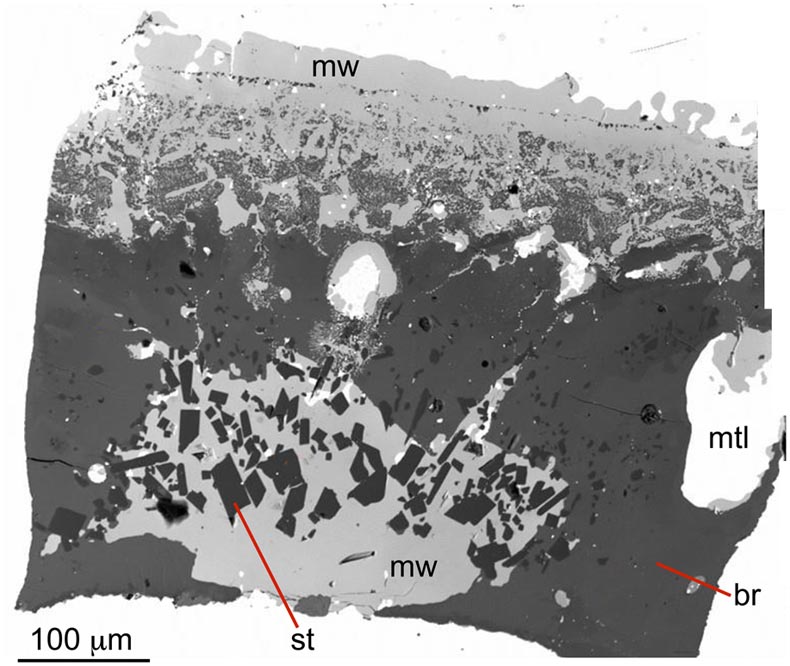
Figure 1 Backscatter electron image of sample BRG 22 (24 GPa, 1700 °C). Magnesiowüstite (mw) is light grey, Pt-bearing Fe metal (mtl) is white, bridgmanite (br) dark grey, and stishovite (st) nearly black.
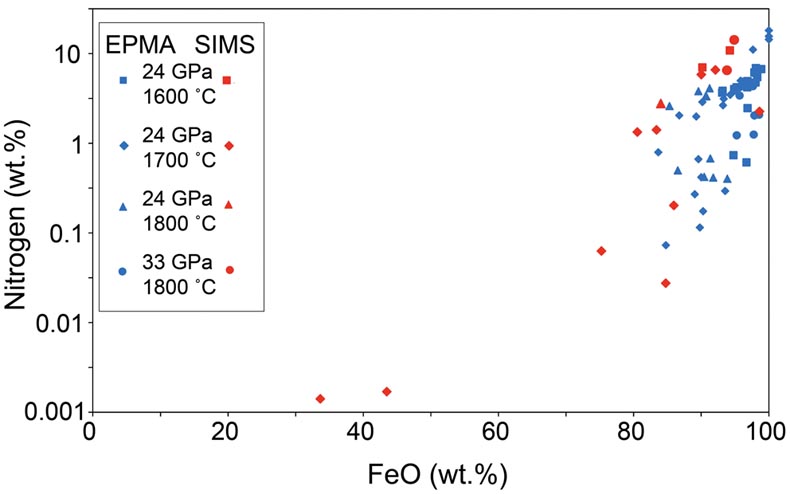
Figure 2 Nitrogen solubility in ferropericlase-magnesiowüstite solid solutions at Fe-FeO buffer conditions. Both data obtained by electron microprobe (EPMA) and by SIMS (secondary ion mass spectrometry) are shown. However, they were never measured at exactly the same spot, as nitrogen is likely lost during the measurements. Data at the same P,T conditions may be from several experiments, see Table S-1.
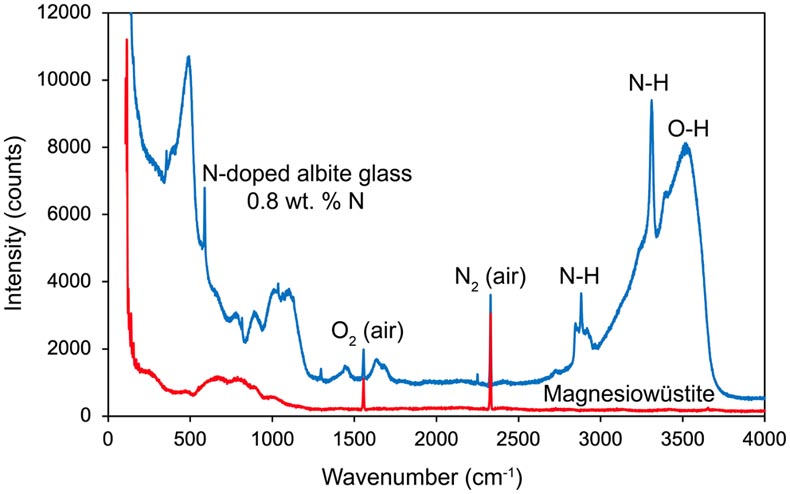
Figure 3 A comparison of the Raman spectrum of nitrogen-rich magnesiowüstite (run BRG 21) with the Raman spectrum of a reduced hydrous N-bearing albite glass with 0.8 wt. % N. The comparison clearly shows that N-H stretching vibrations would be detected in the magnesiowüstite, if the nitrogen were dissolved as ammonium ion or some other N-H species. Both spectra were acquired under the same conditions (2 times 50 s accumulation time, 200 mW output power, 514 nm argon laser).
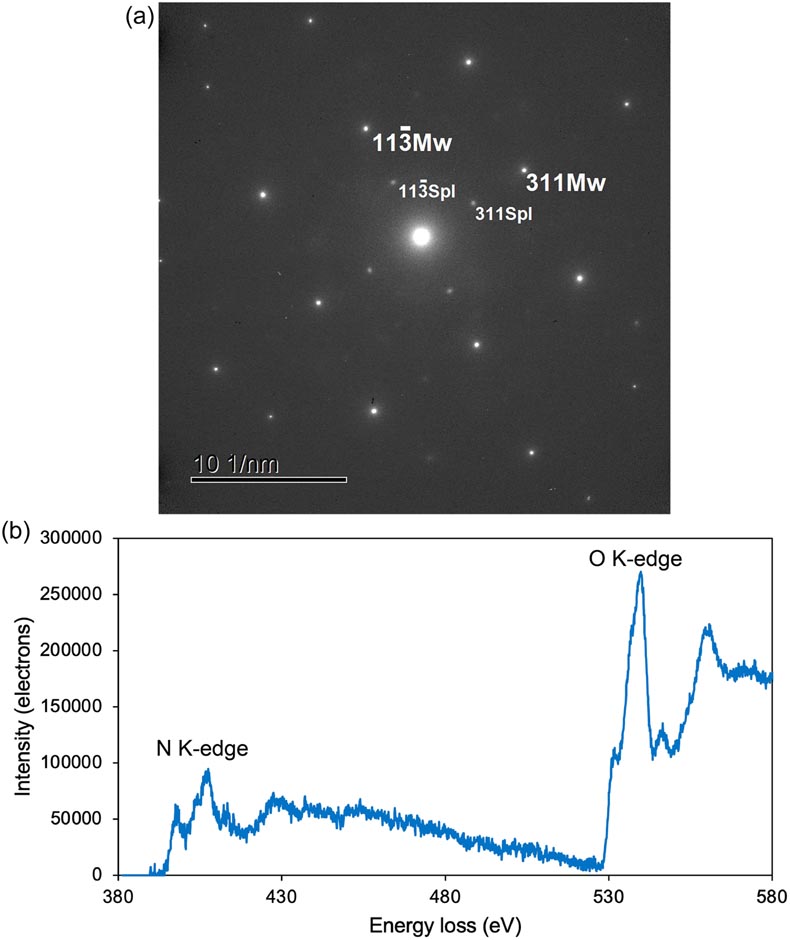
Figure 4 Transmission electron microscopic data on N-bearing magnesiowüstite. (a) Selected area electron diffraction (SAED) pattern of a sample showing that the investigated area is a single crystal of cubic magnesiowüstite (Mw) without phase impurities. Weaker diffraction spots of a spinel phase (Spl) are also visible in a complete topotaxy, with a-axis (Mw) // a-axis (Spl), indicating that this phase likely formed by exsolution during quenching. (b) ELNES (energy loss near edge structure) spectrum of N-bearing magnesiowüstite. The data show that nitrogen is contained in the lattice of the crystal and the environment of N and O are similar.


